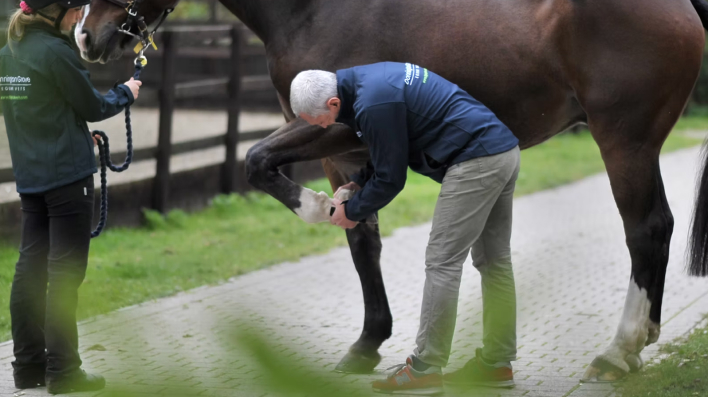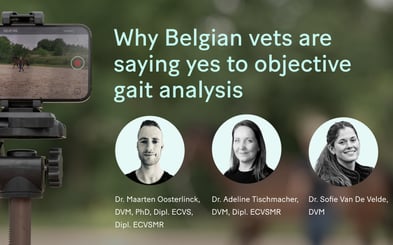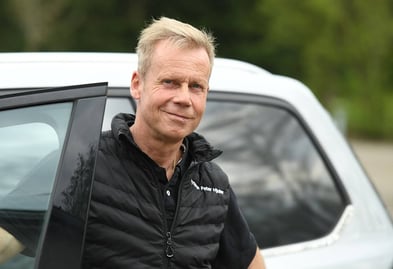Why Belgian vets are saying yes to objective gait analysis
Top Belgian equine veterinarians are clear: Objective gait analysis is becoming as essential as X-rays.

Interview with Giorgio Ricardi, Donnington Grove Equine Vetsi, DrMedVet (Cum laude), CertISELP, MRCVS
Giorgio qualified from the University of Turin in 1989 and completed an equine surgery internship at the Animal Health Trust, Newmarket. He spent over 20 years in private practice in Pisa, combining clinical work with teaching at the University of Pisa. His career later took him to the UAE, working with flat and endurance racehorses, before joining Donnington Grove in 2016. Giorgio is a past president of SIVE and FEEVA, a former board member of ESVOT, and a certified ISELP member. His main focus is orthopaedics, surgery, and advanced imaging in sport and racehorses.

Giorgio Ricardi first arrived at Donnington Grove in 2016, and the clinic acquired their first sensor-based objective gait analysis system shortly after that. “I’ve been using gait analysis ever since,” he says.
Nearly a decade later, Ricardi sees it as integral to his work: “In most of my cases, I’ll record an objective measurement. It gives me that extra layer of insight, especially in subtle lameness cases.”
Ricardi specialises in orthopaedics and surgery, with much of his caseload focused on lameness. For him, objective gait analysis is not a replacement for clinical skill, but an extra piece of the diagnostic puzzle.
“It’s rare that the system disagrees with what I see,” he says. “But when it does, it makes me stop and think. You always want to keep an independent mind, but the data can highlight things you might miss or confirm what you suspected.”
This combination of expertise and objective measurements is especially valuable in complex cases. Ricardi points to blocks where the apparent lame limb changed sides: “You can actually see the horse going lame on the other side after a block, and the data captures that transition very clearly. It’s not just about confirming your impression— it’s also about documenting what happens; this is especially important in low-grade lamenesses, where one is sometimes even hesitant to perform diagnostic blocks”.
“Linking how a horse moves to what we see in imaging, and piecing together the reasons behind it. That’s the satisfaction in my job: solving the puzzle while keeping the horse’s welfare at the centre.”

In one case, a horse’s apparent lameness shifted to the opposite limb after a nerve block. “The system picked this up clearly. It’s useful to have that record — both for clinical reasoning and for teaching owners or colleagues what’s happening.”
Another example involved a horse presenting with a clear hindlimb lameness but also a head nod. “It looked like a forelimb problem, especially to owners and their connections, but the objective data helped confirm it was secondary to the hindlimb issue, not a separate lameness,” he explains.
Ricardi routinely re-records horses that return for follow-up, creating a longitudinal dataset. “It’s very helpful to compare recordings over time. The more data you have on a horse’s history, the better your decisions,” he says.
Although Donnington Grove’s referral setting means owners are not always present, Ricardi finds objective data a valuable communication tool. “Clients really like it. When I show them what the app records, they take it very positively.”
This transparency is particularly relevant in pre-purchase exams. “Buyers increasingly request it, but sellers may be reluctant — sometimes to the point of stopping the process altogether,” he notes. “It’s similar to radiographic findings: some results may be negligible clinically but still affect negotiations. That’s why we need to rethink the whole culture around pre-purchase exams.”
In his congress presentations, Ricardi often illustrates the speed of change with a clip of Sean Connery’s James Bond in the 1960s using a car phone: “At that time it was a dream. Today, everyone has a phone — and we can use that to capture lameness data in the field.”
“The UK horse industry is one of the strongest in the world,” Ricardi says, “and vets here have always been at the front of adopting new technologies. I think uptake of gait analysis reflects that — it’s already quite widespread.”
He sees Sleip as part of this shift: “With the app, you only need a phone. You can record in the yard, and if you don’t have a good signal, you just upload later when you’re back on Wi-Fi. That flexibility makes it usable anywhere.”
Ricardi is confident gait analysis will become standard. For him, the combination of subjective expertise and objective measurement is the real value. “Most of the time, my clinical impression and the data align. But even then, it helps me explain my findings to colleagues, to clients, and to myself. It’s about confidence, clarity, and consistency.”

Top Belgian equine veterinarians are clear: Objective gait analysis is becoming as essential as X-rays.

We sat down with UK Master Farrier Marc Jerram, who blends traditional skill with modern gait analysis to spot issues early and collaborate with vets on targeted solutions.

At Horsedoc in Denmark, founder Peter Hjuler hosted a lameness webinar with remote orthopaedic check-ups. The results revealed just how often early lameness goes unnoticed — and why detection matters.